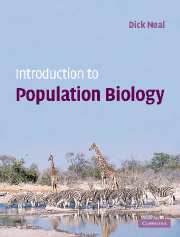Book contents
- Frontmatter
- Contents
- Preface
- Acknowledgements
- PART I Evolution by natural selection
- Chapter 1 Darwin concludes that organisms evolve
- Chapter 2 Darwin's theories of evolution
- Chapter 3 Understanding natural selection
- PART II Simple population growth models and their simulation
- PART III Population genetics and evolution
- PART IV Demography
- PART V Interactions between species, and the behaviour of individuals
- Glossary
- Solutions to problems
- References
- Index
Chapter 2 - Darwin's theories of evolution
- Frontmatter
- Contents
- Preface
- Acknowledgements
- PART I Evolution by natural selection
- Chapter 1 Darwin concludes that organisms evolve
- Chapter 2 Darwin's theories of evolution
- Chapter 3 Understanding natural selection
- PART II Simple population growth models and their simulation
- PART III Population genetics and evolution
- PART IV Demography
- PART V Interactions between species, and the behaviour of individuals
- Glossary
- Solutions to problems
- References
- Index
Summary
Darwin began his ‘Transmutation’ notebooks in the spring of 1837 primarily because of John Gould's taxonomic findings on the birds of the Galápagos Islands. The fact that there were different closely related species of mockingbirds on different islands seemed at odds with the explanation that all species had been created by God (see Chapter 1). Why would a deity create different species, living much the same sort of lifestyle, on islands that were within sight of one another? To Darwin it seemed much more logical that one or more ancestral species had migrated to the islands from South America (where related species were known to occur), and that subsequently they had diverged to form different species on different islands. If that is what had happened on relatively young volcanic islands, imagine how much divergence would be possible worldwide over a much longer geological time period. This transmutation of species would also explain some of the observations he had made in South America. For example, he had found fossils of the giant sloth and the giant armadillo in shallow deposits which indicated that they had become extinct relatively recently. They were also very similar in body form to the present-day species. Perhaps the giant forms had given rise to the smaller species before their demise, or the larger and smaller species had diverged from a common ancestor and the giant forms had lost in the competitive struggle for survival.
- Type
- Chapter
- Information
- Introduction to Population Biology , pp. 19 - 32Publisher: Cambridge University PressPrint publication year: 2003



